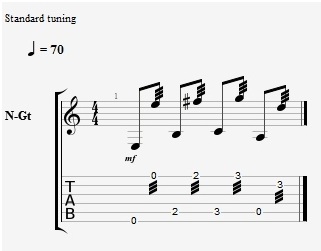Classical Tremolo Technique And Exercise
 Classical guitar playing is a beautiful style, and the tremolo technique, when used properly, can give a note a shimmering quality, which will not only add to the beauty of a piece but will also add dimension.
Classical guitar playing is a beautiful style, and the tremolo technique, when used properly, can give a note a shimmering quality, which will not only add to the beauty of a piece but will also add dimension.
The first thing you need to consider when approaching tremolo picking is your fingers. Do you prefer long nails, or short nails?
If you prefer long nails, be sure that you have a bit better control over your finger. Don’t allow your nails to strike adjacent strings, as this will add extra noise and make your piece sound muddy.
Your Nails Are Your Best Tool – Take Care Of Them
Be sure you take care of your nails as well; frail nails break, and nail breakage is extremely painful for a guitarist. If you prefer short nails, be sure that your calluses are somewhat thick so that you can prevent painful peeling or tearing.
Tremolo is a technique that lengthens the note sound; the effect is made of three simultaneous strokes on a single note of a higher string. The tremolo technique is all about your right hand. The pattern which you will follow when performing a tremolo note is forefinger to middle finger to ring finger. This motion should be fluid.
If you have a bit of trouble with dexterity, that’s okay. Simply take some time to sit down with a metronome. Play a full, slow measure, of a simple four note beat. The first note should be a thumbed bass note, and the three notes afterwards should be simple treble notes. When you play it, be sure to alternate your fingers.
Dexterity is only learned through correct repetition, so be sure to take your time and pay close attention to your form. If you notice that you are playing simultaneous forefinger notes or middle finger notes, slow down a bit and concentrate on using all three main fingers. Once you have the foundation, the classical tremolo technique should become easy.
What Are Tremolo Notes?
Tremolo notes are, individually, thirty second notes. The tremolo notation, while applicable to any note value, simply means that thirty second notes are played for the entire note duration. Take for instance an eighth note tremolo note as we have notated below. An eighth note tremolo note would consist of four thirty second notes. This is what gives the tremolo note its shimmering quality; quicker and smaller notes within a larger note value.
A Simple Drill to Practice With
For our example classical tremolo pattern, both the bass note and the tremolo note are moving melodies. This isn’t always the case; usually it is one or the other. The reason they are combined in this example is simply to make them harder. What was the reason for making the pattern harder? It was so that you will take your time learning it, and develop better techniques.

Download the .gtp file for the lesson ( Right click and Save As… )
If you do not have GuitarPro yet, download a copy instantly here…
Notice the triple set of bars beneath the treble notes. This is the sign for tremolo. Take your time using a metronome, and let your finger get a feel for the pattern.
Once you have learned this classical tremolo picking piece, try writing your own. When you notate, be sure to use the proper symbol (the triple dash line) to represent your tremolo notes.
Everything You Need to Become a Great Guitar Player…
For the most comprehensive step-by-step guitar training program, we highly recommend Gibon’s Learn & Master Guitar course. This award winning DVD course is currently having a 3-day sale and you get to save $100 off the usual price today!
Click here to find out more information and get the course before this promotion ends…







Leave A Comment